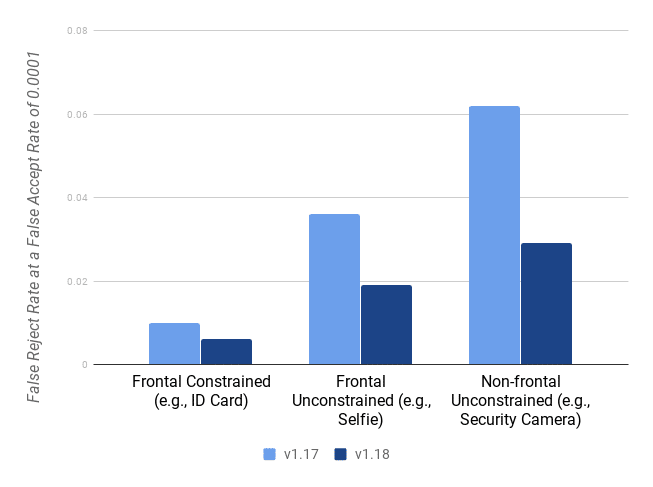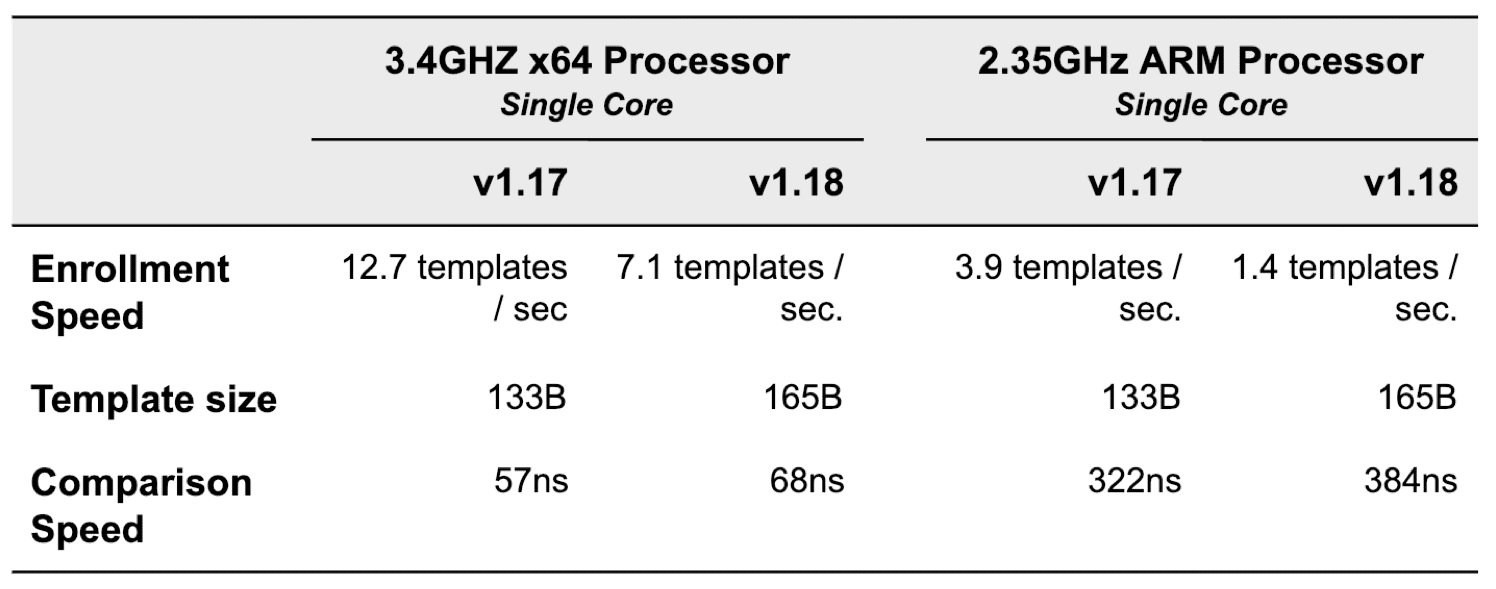The ROC SDK version 1.18 is now available to Rank One’s user community!
This release is one of the most exciting progressions to Rank One’s face recognition algorithms ever delivered, with substantial accuracy improvements and several new features.
Accuracy Improvements
The main highlight of this release is a reduction in error rates between 1.5x and 2x on constrained and unconstrained imagery.
 The above chart reflects testing on internal datasets that roughly correspond to NIST FRVT Ongoing benchmarks.
The above chart reflects testing on internal datasets that roughly correspond to NIST FRVT Ongoing benchmarks.
More important than these broad improvements are how much these gains were achieved by specific efforts to balance accuracy variations across different demographics and environments. With v1.18, the accuracy on dark skinned and female faces is the same as light skinned and male faces were in v1.17. Further, the accuracy for faces with sunglasses, Yaw and Pitch angles from 25° to 45°, and IPD resolutions between 20 and 32 pixels, are all the same accuracy as faces with faces with no sunglasses, Yaw and Pitch angles from 0° to 15°, and IPD resolutions greater than 64 pixels were in v1.17.
Facial Analysis Algorithms
While accuracy variations across different face recognition factors continue to shrink, ROC integrators can help ensure a face image is of suitable quality using the ROC template quality estimator. And, the ROC face analysis algorithms can further provide an accurate understanding of the facial pose angle, gender, race and age.
Speaking of facial analysis algorithms, with v1.18 the ROC SDK now ships with emotion analysis algorithms!
The emotion algorithm only requires a single image and can measure the six universal emotions (happiness, anger, disgust, fear, sadness, and surprise) as well as neutral expressions. The following emotion classification accuracies are achieved on unconstrained face images:

Algorithmic Efficiency
In terms of efficiency, the new face recognition algorithm is slower than v1.17. However, it is still one of the fastest algorithms on the market and is over 5x faster than many of the other algorithms in the NIST validations. Here are the efficiency metrics:

While these efficiency statistics are still industry leading given their accuracy, applications that require even faster processing or less power consumption can use the ROC Embedded algorithm that ships with the SDK.
NIST FRVT Ongoing
Rank One participates in all NIST FRVT benchmarks, and the release of v1.18 was intended to coincide with the next round of submissions to FRVT Ongoing. However, the shutdown of the U.S. Government delayed this next phase which in turn delays when we will have results from v1.18 published by NIST. We suspect the next FRVT Ongoing report will be in late March or early April 2019, and v1.18 will be the ‘rankone-006’ algorithm (though we are not ruling out a quick v1.19 release as we are already sitting on more accuracy gains).
Here is how v1.18 is projected to perform in the next NIST FRVT Ongoing report:
- Frontal Constrained Accuracy: In the most recent Nov. 2018 report the `rankone-005` algorithm, which corresponds to v1.17, had a FRR of 0.014 on Mugshot imagery (at a FAR of 10-4). By comparison, the top performing algorithm in this report has a FRR of 0.013. The error rate reduction on Mugshot imagery for v1.18 was about 1.5x, which means this algorithm should be more accurate than any algorithm than has been measured on this Mugshot benchmark to date.
- Non-frontal Unconstrained Accuracy: There was a 2x reduction in error rates on non-frontal unconstrained imagery with v1.18. This was on Yaw angles up to 45° (in our next version there will be a major focus on Yaw angles between 45° and 90°). As this pertains to the “Wild” dataset in FRVT, which seems to include some variations beyond these angles, we will likely not see a full 2x reduction in error rate but instead somewhere closer to 1.75x. If this holds it would be one of the most accurate algorithms NIST has benchmarked on Wild data.
- Efficiency: v1.18 is poised to be one of the most accurate algorithms ever benchmarked by NIST, and it is over 5x faster than the most accurate algorithms tested in NIST’s most recent report (Nov 2018). We estimate FRVT Ongoing will measure the enrollment speed to be 175ms on their hardware, and the comparison speed to be 405ns. The template is, again, 165 bytes. All of these efficiency metrics make v1.18 one of the fastest algorithms in industry.
–
We are excited to hear from our users on their experiences with v1.18. And, due to our progressive licensing policies, users under active maintenance plans all receive access to these innovations from our research and development team.
Finally, we are already hard at work with v1.19. Early results indicate another round of accuracy improvements, along with several new facial analysis algorithms being added to the SDK.